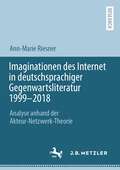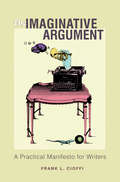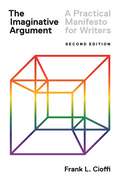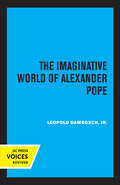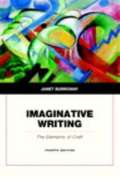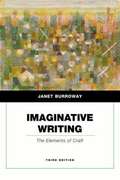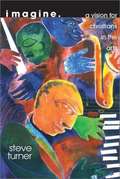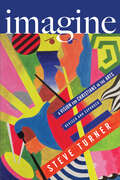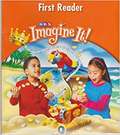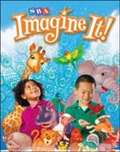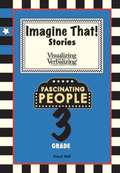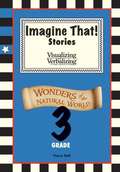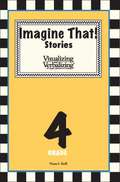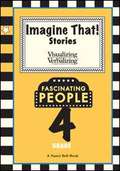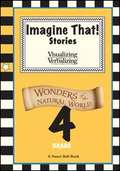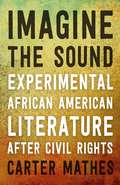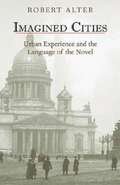- Table View
- List View
Imaginationen des Internet in deutschsprachiger Gegenwartsliteratur 1999-2018: Analyse anhand der Akteur-Netzwerk-Theorie
by Ann-Marie RiesnerIn diesem Buch wird ein Korpus an Texten der deutschsprachigen Gegenwartsliteratur zwischen 1999 und 2018 darauf untersucht, mit welchen inhaltlichen Reflexionen und Metaphern und mit welchen erzählerischen und ästhetischen Mitteln das Internet reflektiert und weitergedacht wird. Über die Akteur-Netzwerk-Theorie nach Bruno Latour wird ein eigener offener Internet-Begriff entwickelt, nach dem das Internet als immer punktuelles und nie finales Zusammenspiel von so diversen Akteuren wie materieller Infrastruktur, Zugangsgeräten, Anwendungen, User*innen-Handlungen, Protokollen, Gesetzen, Konzernstrategien, Imaginationen und Metaphern des Internet uvm. emergiert. Literatur und Imagination sind damit zentrale Akteure in der Aushandlung des Internet, aber auch Stätten, an denen der punktuelle Zusammenschluss der Akteure des Internet zu verschiedenen Zeitpunkten sichtbar gemacht wurden. Anhand eines Korpus von gut 20 literarischen Texten wird eine „Literaturgeschichte des Internet“ über einen Zeitraum von fast 20 Jahren nachgezeichnet. Über die thematische Betrachtung des Internet in den Texten hinaus wurde geprüft, wie die Texte über Erzählverfahren und ästhetische Mittel mit ihren Inhalten umgingen, diese inszenierten und in Dynamik versetzten. Vertiefend untersucht wurden Jana Hensels und Thomas Hettches Web-Anthologie "NULL" (1999), die Print-Romane "Ruhm" von Daniel Kehlmann (2009) und "Follower" von Eugen Ruge (2016), Josephine Rieks Roman "Serverland" (2018) und viele mehr.
The Imaginative Argument: A Practical Manifesto for Writers
by Frank L. CioffiMore than merely a writing text, The Imaginative Argument offers writers instruction on how to use their imaginations to improve their prose. Cioffi shows writers how they can enliven argument--the organizing rubric of all persuasive writing--by drawing on emotion, soul, and creativity, the wellsprings of imagination. While Cioffi suggests that argument should become a natural habit of mind for writers, he goes still further, inspiring writers to adopt as their gold standard the imaginative argument: the surprising yet strikingly apt insight that organizes disparate noises into music, that makes out of chaos, chaos theory. Rather than offering a model of writing based on established formulas or templates, Cioffi urges writers to envision argument as an active parsing of experience that imaginatively reinvents the world. Cioffi's manifesto asserts that successful argument also requires writers to explore their own deep-seated feelings, to exploit the fuzzy but often profoundly insightful logic of the imagination. But expression is not all that matters: Cioffi's work anchors itself in the actual. Drawing on Louis Kahn's notion that a good architect never has all the answers to a building's problems before its physical construction, Cioffi maintains that in argument, too, answers must be forged along the way, as the writer inventively deals with emergent problems and unforeseen complexities. Indeed, discovery, imagination, and invention suffuse all stages of the process. The Imaginative Argument offers all the intellectual kindling that writers need to ignite this creativity, from insights on developing ideas to avoiding bland assertions or logical leaps. It cites exemplary nonfiction prose stylists, including William James, Ruth Benedict, and Erving Goffman, as well as literary sources to demonstrate the dynamic of persuasive writing. Provocative and lively, it will prove not only essential reading but also inspiration for all those interested in arguing more imaginatively more successfully.
The Imaginative Argument: A Practical Manifesto for Writers - Second Edition
by Frank L. CioffiMore than merely a writing text, The Imaginative Argument offers writers instruction on how to use their imaginations to improve their prose. Cioffi shows writers how they can enliven argument—the organizing rubric of all persuasive writing—by drawing on emotion, soul, and creativity, the wellsprings of imagination. While Cioffi suggests that argument should become a natural habit of mind for writers, he goes still further, inspiring writers to adopt as their gold standard the imaginative argument: the surprising yet strikingly apt insight that organizes disparate noises into music, that makes out of chaos, chaos theory.Rather than offering a model of writing based on established formulas or templates, Cioffi urges writers to envision argument as an active parsing of experience that imaginatively reinvents the world. Cioffi's manifesto asserts that successful argument also requires writers to explore their own deep-seated feelings, to exploit the fuzzy but often profoundly insightful logic of the imagination.But expression is not all that matters: Cioffi's work anchors itself in the actual. Drawing on Louis Kahn's notion that a good architect never has all the answers to a building's problems before its physical construction, Cioffi maintains that in argument, too, answers must be forged along the way, as the writer inventively deals with emergent problems and unforeseen complexities. Indeed, discovery, imagination, and invention suffuse all stages of the process.The Imaginative Argument offers all the intellectual kindling that writers need to ignite this creativity, from insights on developing ideas to avoiding bland assertions or logical leaps. It cites exemplary nonfiction prose stylists, including William James, Ruth Benedict, and Erving Goffman, as well as literary sources to demonstrate the dynamic of persuasive writing. Provocative and lively, it will prove not only essential reading but also inspiration for all those interested in arguing more imaginatively more successfully.This edition features new chapters that cover the revision process in greater depth, as well as the particular challenges of researching and writing in the digital age, such as working with technology and avoiding plagiarism. The book also includes new sample essays, an appendix to help instructors use the book in the classroom, and much more.
The Imaginative World of Alexander Pope
by Leopold Damrosch Jr.This title is part of UC Press's Voices Revived program, which commemorates University of California Press’s mission to seek out and cultivate the brightest minds and give them voice, reach, and impact. Drawing on a backlist dating to 1893, Voices Revived makes high-quality, peer-reviewed scholarship accessible once again using print-on-demand technology. This title was originally published in 1987.
Imaginative Writing: The Elements of Craft
by Janet BurrowayWritten by bestselling author Janet Burroway, Imaginative Writing, covers all four genres: creative nonfiction, fiction, poetry, and drama. This textbook discusses elements of craft common to all creative writing before delving into the individual genres. After an introduction, the next five chapters each investigate a specific element of craft–Image, Voice, Character, Setting, and Story–from a perspective that crosses all genres. Nearly half of the selections in all four genres are new. New "Try This" exercises give students plenty of practice. Imaginative Writing is a very popular book for courses on teaching the craft of creative writing.
Imaginative Writing: The Elements of Craft (3rd edition)
by Janet BurrowayThis resource and anthology emphasizes technique, experimentation, development, and revision, encouraging a sense of enthusiastic play and adventure for students in introductory creative writing courses. Burroway begins with the elements of craft including image, voice, character, setting, and story, before exploring specific genres such as essay, fiction, poetry, and drama. Each chapter begins with a photographic or graphic image accompanied by a warm-up exercise. Burroway (Florida State U. ) is the author of plays, poetry, children's books, and several novels. Her textbook is popular in college writing courses.
Imaginative Writing: The Elements Of Craft (Penguin Academics)
by Janet BurrowayWritten by best-selling author Janet Burroway, Imaginative Writing — an introduction to creative writing — covers all four genres: creative nonfiction, fiction, poetry, and drama. Imaginative Writing discusses elements of craft common to all creative writing before delving into the individual genres. Each of the first five chapters investigates a specific element of craft–Image, Voice, Character, Setting, and Story–from a perspective that crosses all genres. Chapter 6 explores development and revision and serves as a bridge between the craft chapters and genre chapters. The last four chapters examine individual genres: Creative Nonfiction, Fiction, Poetry, and Drama. This unique organization allows students to experiment with creative techniques shared by all genres before deciding which form best suits their imagination. Unique "Try-This" exercises help students develop writing skills, while new “Working Toward a Draft” exercises encourage students to think ahead about the direction and possibilities of their work
Imagine: A Vision for Christians in the Arts
by Steve TurnerImagine music, movies, books and paintings of the highest quality! Imagine art that permeates society, challenging conventional thinking and standard morals to their core! Imagine that it is all created by Christians! This is the bold vision of Steve Turner, someone who has worked among artists--many Christian and many not--for three decades.
Imagine: A Vision for Christians in the Arts
by Steve TurnerImagine art that is risky, complex, and subtle. Imagine music, movies, books, and paintings of the highest quality. Imagine art that permeates society, challenging conventional thinking and standard morals to their core. Imagine that it is all created by Christians! This is the bold vision of Steve Turner, who has worked among a wide variety of artists for decades. He believes Christians should confront society and the church using art's powerful impact. Art can faithfully chronicle the lives of ordinary people and express the transcendence of God. And Christians should be involved in every level of the art world and in every medium. In this revised and expanded edition of a contemporary classic, Turner builds a compelling case for Christians in the arts. If Jesus is Lord of all of life and creation, then art is part of his cultural mandate. It can and should be a way of expressing faith through creatively, beautifully, and truthfully arranged words, sounds, and sights. Now includes study questions for individual reflection or group discussion.
Imagine It!, First Reader, Level 1, Unit 1 [Grade 1]
by Joe Campione Andy Biemiller Carl BereiterTextbook.
Imagine It!, Student Reader Book 1, Grade 1
by Sra Mcgraw-HillStudents can access selections as well as practice and support for fluency, vocabulary, and comprehension.
Imagine It!, Student Reader Book 1, Grade 1
by Sra Mcgraw-HillStudents can access selections as well as practice and support for fluency, vocabulary, and comprehension.
Imagine Otherwise: On Asian Americanist Critique
by Kandice ChuhImagine Otherwise is an incisive critique of the field of Asian American studies. Recognizing that the rubric "Asian American" elides crucial differences, Kandice Chuh argues for reframing Asian American studies as a study defined not by its subjects and objects, but by its critique. Toward that end, she urges the foregrounding of the constructedness of "Asian American" formations and shows how this understanding of the field provides the basis for continuing to use the term "Asian American" in light of--and in spite of--contemporary critiques about its limitations. Drawing on the insights of poststructuralist theory, postcolonial studies, and investigations of transnationalism, Imagine Otherwise conceives of Asian American literature and U. S. legal discourse as theoretical texts to be examined for the normative claims about race, gender, and sexuality that they put forth. Reading government and legal documents, novels including Carlos Bulosan's America Is in the Heart, John Okada's No-No Boy, Chang-rae Lee's A Gesture Life, Ronyoung Kim's Clay Walls, and Lois Ann Yamanaka's Blu's Hanging, and the short stories "Immigration Blues" by Bienvenido Santos and "High-Heeled Shoes" by Hisaye Yamamoto, Chuh works through Filipino American and Korean American identity formation and Japanese American internment during World War II as she negotiates the complex and sometimes tense differences that constitute 'Asian America' and Asian American studies.
Imagine That! Stories: Wonders of the Natural World Grade 3
by Nanci BellLanguage Arts Textbook Grade 3
Imagine That! Stories: Visualizing and Verbalizing for Language Comprehension and Thinking 4th Grade
by Nanci BellLanguage Arts Textbook Grade 4:
Imagine That! Stories Grade 2: Visualizing And Verbalizing
by Nanci BellThe mysterious, the unusual, the unexplained... Imagery is the medium through which language that describes our diverse world is revealed in all its detail and complexity. The Imagine That! series provides nonfiction stories with which to practice building imagery for oral and written language comprehension. These challenging, high-imagery stories introduce true and unusual topics for students to visualize, including natural disasters, legends, unique animals, odd plants, mysteries, fascinating phenomena, and people of great achievement. Each story is presented in language appropriate to the grade level, and the content is sure to capture the interest of students and instructors alike.
Imagine That! Stories Grade 3: Visualizing And Verbalizing
by Nanci Bell Valarie JonesThird Grade Language Comprehension and Thinking
Imagine That! Stories Wonders of the Natural World Grade 4
by Nanci BellLanguage Arts Textbook 4th Grade
Imagine the Sound: Experimental African American Literature after Civil Rights
by Carter MathesThe post–Civil Rights era was marked by an explosion of black political thought and aesthetics. Reflecting a shifting horizon of expectations around race relations, the unconventional sounds of free jazz coupled with experimental literary creation nuanced the push toward racial equality and enriched the possibilities for aesthetic innovation within the Black Arts Movement. In Imagine the Sound, Carter Mathes demonstrates how African American writers used sound to further artistic resistance within a rapidly transforming political and racial landscape. While many have noted the oral and musical qualities of African American poetry from the post–Civil Rights period, Mathes points out how the political implications of dissonance, vibration, and resonance produced in essays, short stories, and novels animated the ongoing struggle for equality. Situating literary works by Henry Dumas, Larry Neal, and Toni Cade Bambara in relation to the expansive ideas of sound proposed by free jazz musicians such as Marion Brown and Sun Ra, not only does this book illustrate how the presence of sound can be heard and read as political, but it recuperates critically neglected, yet important, writers and musicians. Ultimately, Mathes details how attempts to capture and render sound through the medium of writing enable writers to envision alternate realities and resistance outside of the linear frameworks offered by the Civil Rights and Black Power movements.In precise and elegant prose, Mathes shows how in conceptualizing sound, African American writers opened up the political imaginations of their readers. By exploring this intellectual convergence of literary artistry, experimental music, and sound theory, Imagine the Sound reveals how taking up radically new forms of expression allows us to speak to the complexities of race and political resistance.
Imagined Cities: Urban Experience and the Language of the Novel
by Robert AlterRobert Alter traces the arc of literary development triggered by the runaway growth of urban centers from the early nineteenth century through the first two decades of the twentieth. As new technologies and arrangements of public and private space changed the ways people experienced time and space, the urban panorama became less coherent-a metropolis defying traditional representation and definition, a vast jumble of shifting fragments and glimpses-and writers were compelled to create new methods for conveying the experience of the city. In a series of subtle and convincing interpretations of novels by Flaubert, Dickens, Bely, Woolf, Joyce, and Kafka, Alter reveals the ways the city entered the literary imagination. He shows how writers of diverse imaginative temperaments developed innovative techniques to represent shifts in modern consciousness. Writers sought more than a journalistic representation of city living, he argues, and to convey meaningfully the reality of the metropolis, the city had to be re-created or reimagined. His book probes the literary response to changing realities of the period and contributes significantly to our understanding of the history of the Western imagination.
